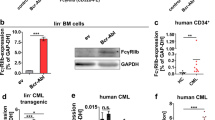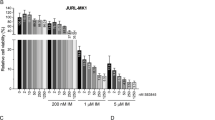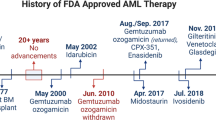Abstract
The introduction of Abl tyrosine kinase inhibitors (TKI; that is, imatinib, dasatinib and nilotinib) as front-line therapy completely changed the course of chronic myelogenous leukemia (CML) to the point that most of the TKI-responsive newly diagnosed CML patients can be considered ‘clinically’ cured and their progression into blast crisis (BC) a rare event. However, a therapy for those patients who transform is still lacking, and TKIs do not eradicate CML at the stem cell level, therefore leaving a reservoir of cancer stem cells in a dormant stage. Thus, it is not surprising that the focus of CML research has shifted significantly toward the dissection of the mechanisms regulating the survival and self-renewal of TKI-resistant Philadelphia-positive leukemic chronic phase and BC stem cells, with the ultimate goal of developing small molecules capable of selectively killing leukemic but not normal hematopoietic stem cells, thereby achieving a ‘biological’ cure for this disease.
This is a preview of subscription content, access via your institution
Access options
Subscribe to this journal
We are sorry, but there is no personal subscription option available for your country.
Buy this article
- Purchase on Springer Link
- Instant access to full article PDF
Prices may be subject to local taxes which are calculated during checkout
Similar content being viewed by others
References
Perrotti D, Jamieson C, Goldman J, Skorski T . Chronic myeloid leukemia: mechanisms of blastic transformation. J Clin Invest 2010; 120: 2254–2264.
Quintas-Cardama A, Cortes J . Molecular biology of BCR-ABL1-positive chronic myeloid leukemia. Blood 2008; 113: 1619–1630.
Goldman JM . Initial treatment for patients with CML. Hematology Am Soc Hematol Educ Program 2009, 453–460.
Hughes TP, Branford S . Monitoring disease response to tyrosine kinase inhibitor therapy in CML. Hematology Am Soc Hematol Educ Program 2009, 477–487.
Rousselot P, Huguet F, Rea D, Legros L, Cayuela JM, Maarek O et al. Imatinib mesylate discontinuation in patients with chronic myelogenous leukemia in complete molecular remission for more than 2 years. Blood 2007; 109: 58–60.
Sobrinho-Simoes M, Wilczek V, Score J, Cross NC, Apperley JF, Melo JV . In search of the original leukemic clone in chronic myeloid leukemia patients in complete molecular remission after stem cell transplantation or imatinib. Blood 2010; 116: 1329–1335.
Copland M, Hamilton A, Elrick LJ, Baird JW, Allan EK, Jordanides N et al. Dasatinib (BMS-354825) targets an earlier progenitor population than imatinib in primary CML but does not eliminate the quiescent fraction. Blood 2006; 107: 4532–4539.
Graham SM, Jorgensen HG, Allan E, Pearson C, Alcorn MJ, Richmond L et al. Primitive, quiescent, Philadelphia-positive stem cells from patients with chronic myeloid leukemia are insensitive to STI571 in vitro. Blood 2002; 99: 319–325.
Holtz MS, Forman SJ, Bhatia R . Nonproliferating CML CD34+ progenitors are resistant to apoptosis induced by a wide range of proapoptotic stimuli. Leukemia 2005; 19: 1034–1041.
Jorgensen HG, Allan EK, Jordanides NE, Mountford JC, Holyoake TL . Nilotinib exerts equipotent antiproliferative effects to imatinib and does not induce apoptosis in CD34+ CML cells. Blood 2007; 109: 4016–4019.
Brazma D, Grace C, Howard J, Melo JV, Holyoke T, Apperley JF et al. Genomic profile of chronic myelogenous leukemia: Imbalances associated with disease progression. Genes Chromosomes Cancer 2007; 15: 15.
Calabretta B, Perrotti D . The biology of CML blast crisis. Blood 2004; 103: 4010–4022.
Eiring AM, Harb JG, Neviani P, Garton C, Oaks JJ, Spizzo R et al. miR-328 functions as an RNA decoy to modulate hnRNP E2 regulation of mRNA translation in leukemic blasts. Cell 2010; 140: 652–665.
Jamieson CH, Ailles LE, Dylla SJ, Muijtjens M, Jones C, Zehnder JL et al. Granulocyte-macrophage progenitors as candidate leukemic stem cells in blast-crisis CML. N Engl J Med 2004; 351: 657–667.
Neviani P, Santhanam R, Trotta R, Notari M, Blaser BW, Liu S et al. The tumor suppressor PP2A is functionally inactivated in blast crisis CML through the inhibitory activity of the BCR/ABL-regulated SET protein. Cancer Cell 2005; 8: 355–368.
Corbin AS, Agarwal A, Loriaux M, Cortes J, Deininger MW, Druker BJ . Human chronic myeloid leukemia stem cells are insensitive to imatinib despite inhibition of BCR-ABL activity. J Clin Invest 2011; 121: 396–409.
Chu S, Xu H, Shah NP, Snyder DS, Forman SJ, Sawyers CL et al. Detection of BCR-ABL kinase mutations in CD34+ cells from chronic myelogenous leukemia patients in complete cytogenetic remission on imatinib mesylate treatment. Blood 2005; 105: 2093–2098.
Jordanides NE, Jorgensen HG, Holyoake TL, Mountford JC . Functional ABCG2 is overexpressed on primary CML CD34+ cells and is inhibited by imatinib mesylate. Blood 2006; 108: 1370–1373.
Bhatia R, Holtz M, Niu N, Gray R, Snyder DS, Sawyers CL et al. Persistence of malignant hematopoietic progenitors in chronic myelogenous leukemia patients in complete cytogenetic remission following imatinib mesylate treatment. Blood 2003; 101: 4701–4707.
Neviani P, Harb JG, Oaks JJ, Walker CJ, Santhanam R, Paisie C et al. BCR-ABL1 kinase activity but not its expression is dispensable for Ph+ quiescent stem cell survival which depends on the PP2A-controlled Jak2 activation and is sensitive to FTY720 treatment. Blood 2010; 116 (ASH Annual Meeting Abstracts #515).
Traer E, Mackenzie R, Snead J, Agarwal A, Eiring AM, O’Hare T et al. Blockade of JAK2-mediated extrinsic survival signals restores sensitivity of CML cells to ABL inhibitors. Leukemia 2011; 26: 1140–1143.
Lin H, Lorenzi M, Woolfson A, Jiang X . Targeting the CML stem/progenitor cell with JAK2 (BMS-911543)/ABL inhibitor combination therapy. ASH Annu Meet Abstr 2011; 118: 2743.
Court Recart AC, Sadarangani A, Goff D, Shih AY, Wall R, Leu H et al. Combination targeted therapy to impair self-renewal capacity of human blast crisis leukemia stem cells. ASH Annu Meet Abstr 2011; 118: 1693–169.
Zhang B, Strauss AC, Chu S, Li M, Ho Y, Shiang KD et al. Effective targeting of quiescent chronic myelogenous leukemia stem cells by histone deacetylase inhibitors in combination with imatinib mesylate. Cancer Cell 2010; 17: 427–442.
Shih AY, Schairer A, Barrett CL, Geron I, Recart ACC, Goff D et al. Cycling toward leukemia stem cell elimination with a selective sonic Hedgehog antagonist. ASH Annu Meet Abstr 2011; 118: 3776.
Goff D, Smith KM, Shih AY, Court-Recart A, Sadarangani A, Geron I et al. BCL2 splice isoform switching promotes leukemia stem cell survival and sensitivity to a novel Pan BCL2 inhibitor. ASH Annu Meet Abstr 2011; 118: 2735–273.
Harb JG, Neviani P, Huettner CS, Marcucci G, Perrotti D . Combined pharmacologic inhibition of Bcl-Xl/Bcl-2 and mTORC1/2 survival signals trigger apoptosis in BCR-ABL1+ in vitro models of blast crisis chronic myelogenous leukemia (CML-BC), and primary CD34+/CD38- stem and CD34+ progenitor cells from CML-BC patients. ASH Annu Meet Abstr 2011; 118: 2738.
Papayannidis C, Guadagnuolo V, Iacobucci I, Durante S, Terragna C, Ottaviani E et al. PF-04449913 reverts multi drug resistance (MDR) by a strong down-regulation of ABCA2 and BCL2 on leukemia stem cells in phase i acute myeloid leukemia and chronic myeloid leukemia treated patients. ASH Annu Meet Abstr 2011; 118: 1429.
Bellodi C, Lidonnici MR, Hamilton A, Helgason GV, Soliera AR, Ronchetti M et al. Targeting autophagy potentiates tyrosine kinase inhibitor-induced cell death in Philadelphia chromosome-positive cells, including primary CML stem cells. J Clin Invest 2009; 119: 1109–1123.
Heaney NB, Pellicano F, Zhang B, Crawford L, Chu S, Kazmi SM et al. Bortezomib induces apoptosis in primitive chronic myeloid leukemia cells including LTC-IC and NOD/SCID repopulating cells. Blood 2010; 115: 2241–2250.
Jaras M, Johnels P, Hansen N, Agerstam H, Tsapogas P, Rissler M et al. Isolation and killing of candidate chronic myeloid leukemia stem cells by antibody targeting of IL-1 receptor accessory protein. Proc Natl Acad Sci USA 2010; 107: 16280–16285.
Kijima M, Gardiol N, Held W . Natural killer cell mediated missing-self recognition can protect mice from primary chronic myeloid leukemia in vivo. PLoS ONE 2011; 6: e27639.
Dierks C, Beigi R, Guo GR, Zirlik K, Stegert MR, Manley P et al. Expansion of Bcr-Abl-positive leukemic stem cells is dependent on Hedgehog pathway activation. Cancer Cell 2008; 14: 238–249.
Ito K, Bernardi R, Morotti A, Matsuoka S, Saglio G, Ikeda Y et al. PML targeting eradicates quiescent leukaemia-initiating cells. Nature 2008; 453: 1072–1078.
Zhao C, Blum J, Chen A, Kwon HY, Jung SH, Cook JM et al. Loss of beta-catenin impairs the renewal of normal and CML stem cells in vivo. Cancer Cell 2007; 12: 528–541.
Pellicano F, Copland M, Jorgensen HG, Mountford J, Leber B, Holyoake TL . BMS-214662 induces mitochondrial apoptosis in chronic myeloid leukemia (CML) stem/progenitor cells, including CD34+38- cells, through activation of protein kinase Cbeta. Blood 2009; 114: 4186–4196.
Li L, Wang L, Li L, McDonald T, Ho YW, Holyoake TL et al. Pharmacological inhibition of the stress-related deacetylase SIRT1 enhances eradication of cml stem cells. ASH Annu Meet Abstr 2011; 118: 448.
Nieborowska-Skorska M, Kopinski P, Ray R, Hoser G, Ngaba D, Flis S et al. Targeting Rac2—mitochondrial respiratory chain complex iii signaling to prevent genomic instability in leukemia stem and progenitor cells. ASH Annu Meet Abstr 2011; 118: 2736.
Aktas O, Kury P, Kieseier B, Hartung HP . Fingolimod is a potential novel therapy for multiple sclerosis. Nat Rev Neurol 2010; 6: 373–382.
Kappos L, Radue EW, O’Connor P, Polman C, Hohlfeld R, Calabresi P et al. A placebo-controlled trial of oral fingolimod in relapsing multiple sclerosis. N Engl J Med 2010; 362: 387–401.
Brinkmann V . FTY720 (fingolimod) in multiple sclerosis: therapeutic effects in the immune and the central nervous system. Br J Pharmacol 2009; 158: 1173–1182.
Neviani P, Santhanam R, Oaks JJ, Eiring AM, Notari M, Blaser BW et al. FTY720, a new alternative for treating blast crisis chronic myelogenous leukemia and Philadelphia chromosome-positive acute lymphocytic leukemia. J Clin Invest 2007; 117: 2408–2421.
Perrotti D, Neviani P . Protein phosphatase 2A (PP2A), a druggable tumor suppressor in Ph1(+) leukemias. Cancer Metastasis Rev 2008; 27: 159–168.
Nagaoka Y, Otsuki K, Fujita T, Uesato S . Effects of phosphorylation of immunomodulatory agent FTY720 (fingolimod) on antiproliferative activity against breast and colon cancer cells. Biol Pharm Bull 2008; 31: 1177–1181.
Roberts KG, Smith AM, McDougall F, Carpenter H, Horan M, Neviani P et al. Essential requirement for PP2A inhibition by the oncogenic receptor c-KIT suggests PP2A reactivation as a strategy to treat c-KIT+ cancers. Cancer Res 2010; 70: 5438–5447.
Zemann B, Kinzel B, Muller M, Reuschel R, Mechtcheriakova D, Urtz N et al. Sphingosine kinase type 2 is essential for lymphopenia induced by the immunomodulatory drug FTY720. Blood 2006; 107: 1454–1458.
Agarwal A, MacKenzie R, Oddo J, Vitek MP, Christensen DJ, Druker BJ . A novel SET antagonist (OP449) is cytotoxic to CML cells, including the highly-resistant BCR-ABLT315I mutant, and demonstrates enhanced efficacy in combination with ABL tyrosine kinase inhibitors. ASH Annu Meet Abstr 2011; 118: 3757.
Gozgit JM, Wong MJ, Wardwell S, Tyner JW, Loriaux MM, Mohemmad QK et al. Potent activity of ponatinib (AP24534) in models of FLT3-driven acute myeloid leukemia and other hematologic malignancies. Mol Cancer Ther 2011; 10: 1028–1035.
O’Hare T, Deininger MW, Eide CA, Clackson T, Druker BJ . Targeting the BCR-ABL signaling pathway in therapy-resistant Philadelphia chromosome-positive leukemia. Clin Cancer Res 2011; 17: 212–221.
Zhou T, Commodore L, Huang WS, Wang Y, Thomas M, Keats J et al. Structural mechanism of the Pan-BCR-ABL inhibitor ponatinib (AP24534): lessons for overcoming kinase inhibitor resistance. Chem Biol Drug Des 2011; 77: 1–11.
Takeuchi M, Kimura S, Kuroda J, Ashihara E, Kawatani M, Osada H et al. Hypoxia-adapted CML cells are more primitive population and are eradicated by glyoxalase-1 inhibitors. Blood (Suppl) 2009; 114: 2166.
Ng K-P, Poh TY, Sun WT, Chuah C, Ong ST . Physiologic hypoxia protects chronic myelogenous leukemia progenitors from elimination by imatinib mesylate. Blood (Suppl) 2009; 114: 2181.
Author information
Authors and Affiliations
Corresponding author
Ethics declarations
Competing interests
DP received consulting fees from Pfizer, grant support from the NIH and Karyopharm Therapeutics and has a patent pending for PP2A-activating drugs for CML.
Additional information
This article was published as part of a supplement that was supported by Novartis, MSD Italia, Roche, Celgene, GlaxoSmithKline, Sanofi, Gilead, Adienne, Italfarmaco, Pierre Fabre Pharmaceuticals with an unrestricted educational contribution to AREO—Associazione Ricerche Emato-Oncologiche (Genoa) and AMS—Associazione Malattie del Sangue (Milan) for the purpose of advancing research in acute and chronic leukemia.
Rights and permissions
About this article
Cite this article
Perrotti, D. Where are we going with CML research?. Leukemia Suppl 1 (Suppl 2), S51–S53 (2012). https://doi.org/10.1038/leusup.2012.26
Published:
Issue Date:
DOI: https://doi.org/10.1038/leusup.2012.26



